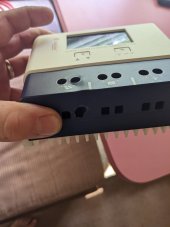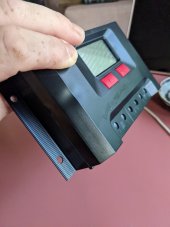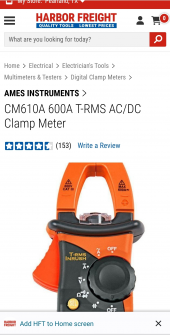Hello, I'm new here and new to solar. I bought a 400w Grape solar kit from a big box store about 6 months ago. It included two 200w panels and a 40A PWM controller. I added a single Renogy 200ah AGM battery and a 2000w pure sine inverter. The panels each have a 20A fuse inline before the controller. I am using 40' of 10AWG wire from the panels. The panels are connected together with the included Y connectors, + to + and - to -.
This system mainly powers a mini fridge which draws 54w while running, and runs between 25 and 50% of the time depending on ambient temperature. We also charge two cell phones, a tablet and a run a single 6w lightbulb. I also have a 3.5a 12v water pump that gets used for the shower. That is wired direct to the battery, as is the 2000w inverter.
Everything work fine for the last six months, despite mostly cloudy and rainy weather this summer and having trees blocking direct sunlight for half the day. Then I noticed that my battery was getting lower and lower over the course of a couple weeks. I was used to seeing a readout of 13-14V while charging, and 12.7-12.8V a while after the sun went down. But now it was only getting up to 12.2-12.4 at rest. One day I came home from work and found the battery down to 11.7V.
I panicked and worried I'd done major damage to my expensive battery and started frantically checking all my connections. That's when I noticed the negative solar panel connector on the controller was melted as was the plastic around it. The connection still felt tight. I disconnected the controller and called around for a replacement. Unfortunately the only place around that had one was Harbor Freight and the biggest one they had was 30A. I thought this would get me by for a week while I wait for a new 40A controller in the mail. I know my panels are capable of exceeding 30A but I watch the readout obsessively and have never seen them go higher than 24.5A.
I connected the controller to the battery and all seemed well. As soon as I hooked up the panels the new temporary controller it started beeping like crazy. It wouldn't tell me what was wrong but for a moment I got it to chill out and it was displaying an input current of 33.5 amps! I found this reading to be dubious because it was 4pm, 25% of the panels area was shaded by a tree and even it direct sun I've only ever seen 24.5 amps. So, I took one 200w panel out of the circuit and the readout changed to 14.5 amps. That still seemed way off to me but I felt safer for the time being.
The next day I came home to a voltage of 12.0 after a mostly sunny day. The panel was in pretty decent light but the controller readout was 0 amps. I rechecked my connections and nothing. Out of curiosity I reconnected both panels because by this point the sun was mostly obscured by trees. It immediately jumped up to 33 amps again and started beeping. I disconnected the second panel and it dropped back down to 0 amps. At this point I walked away for the day.
Next day at work I get an urgent text from my wife. The controller is beeping again, this time with only one panel connected. I told her to cover the panel with a blanket and see if it stops and it did. I come home from work and my battery is now down to 11.7V despite me charging the battery to 100% with my generator and a 15a charger before bed the previous night. So I disconnected the controller and re-connected my 15a battery charger. Upon inspection I noticed that this controller had melted as well. This time not at the terminal but about midway up the chassis, as if something internal caused the heat.
I'm at a loss. I'm afraid to connect my new controller when it arrives later this week. Clearly something is right. I don't have more money to throw at this set up and now I'm deeply regretting not just buying a propane refrigerator. Can someone please help?
This system mainly powers a mini fridge which draws 54w while running, and runs between 25 and 50% of the time depending on ambient temperature. We also charge two cell phones, a tablet and a run a single 6w lightbulb. I also have a 3.5a 12v water pump that gets used for the shower. That is wired direct to the battery, as is the 2000w inverter.
Everything work fine for the last six months, despite mostly cloudy and rainy weather this summer and having trees blocking direct sunlight for half the day. Then I noticed that my battery was getting lower and lower over the course of a couple weeks. I was used to seeing a readout of 13-14V while charging, and 12.7-12.8V a while after the sun went down. But now it was only getting up to 12.2-12.4 at rest. One day I came home from work and found the battery down to 11.7V.
I panicked and worried I'd done major damage to my expensive battery and started frantically checking all my connections. That's when I noticed the negative solar panel connector on the controller was melted as was the plastic around it. The connection still felt tight. I disconnected the controller and called around for a replacement. Unfortunately the only place around that had one was Harbor Freight and the biggest one they had was 30A. I thought this would get me by for a week while I wait for a new 40A controller in the mail. I know my panels are capable of exceeding 30A but I watch the readout obsessively and have never seen them go higher than 24.5A.
I connected the controller to the battery and all seemed well. As soon as I hooked up the panels the new temporary controller it started beeping like crazy. It wouldn't tell me what was wrong but for a moment I got it to chill out and it was displaying an input current of 33.5 amps! I found this reading to be dubious because it was 4pm, 25% of the panels area was shaded by a tree and even it direct sun I've only ever seen 24.5 amps. So, I took one 200w panel out of the circuit and the readout changed to 14.5 amps. That still seemed way off to me but I felt safer for the time being.
The next day I came home to a voltage of 12.0 after a mostly sunny day. The panel was in pretty decent light but the controller readout was 0 amps. I rechecked my connections and nothing. Out of curiosity I reconnected both panels because by this point the sun was mostly obscured by trees. It immediately jumped up to 33 amps again and started beeping. I disconnected the second panel and it dropped back down to 0 amps. At this point I walked away for the day.
Next day at work I get an urgent text from my wife. The controller is beeping again, this time with only one panel connected. I told her to cover the panel with a blanket and see if it stops and it did. I come home from work and my battery is now down to 11.7V despite me charging the battery to 100% with my generator and a 15a charger before bed the previous night. So I disconnected the controller and re-connected my 15a battery charger. Upon inspection I noticed that this controller had melted as well. This time not at the terminal but about midway up the chassis, as if something internal caused the heat.
I'm at a loss. I'm afraid to connect my new controller when it arrives later this week. Clearly something is right. I don't have more money to throw at this set up and now I'm deeply regretting not just buying a propane refrigerator. Can someone please help?
Last edited:






